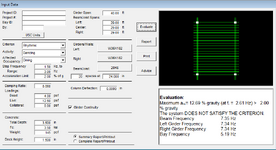mfstructural
Structural
All,
I'm working on a project where the client purchased a building without consulting a structural engineer regarding the floor system. The building is two stories, no basement. There are multiple column lines spaced 29' in one direction, with HSS columns spaced at 25' and 40' in the other direction. the 40' span is in the middle of the building. The steel joists are 18k4 @ 2' o.c. spanning in the 29' directions supported by W24x62 girders. The second story of the building was originally designed for a LL of 75 psf per the designed drawings from 1999. The owner wants to convert the building from store/office use to a banquet hall, which is 100 psf LL. The joists showed that the top chord, bottom chord, and 3 web members at the ends required reinforcing for strength, which is pretty straightforward. The issue then becomes when the floor is evaluated for vibration from dancing. I reviewed AISC Design Guide 11 and used the floorvibe software to evaluate the floor. The software output states that the existing system doesn't work which makes sense based on LL also increasing.

Assuming the WF girders and joists are reinforced approximating the section properties below, the system still does not work for vibration.

I wanted to see if anyone else has come across something like this. I understand the criterion, but from a judgement perspective I am trying to understand if performing all the reinforcing will work and not yield excessive vibration. The acceleration is worse with less LL, presumably because there is less load "weighing" down the joists and girders.
Will a W24x62 really vibrate to that extent under load?
If I reduce the girder span to 13' (place a column underneath) it works but that is not an option per the client.
Thanks,
I'm working on a project where the client purchased a building without consulting a structural engineer regarding the floor system. The building is two stories, no basement. There are multiple column lines spaced 29' in one direction, with HSS columns spaced at 25' and 40' in the other direction. the 40' span is in the middle of the building. The steel joists are 18k4 @ 2' o.c. spanning in the 29' directions supported by W24x62 girders. The second story of the building was originally designed for a LL of 75 psf per the designed drawings from 1999. The owner wants to convert the building from store/office use to a banquet hall, which is 100 psf LL. The joists showed that the top chord, bottom chord, and 3 web members at the ends required reinforcing for strength, which is pretty straightforward. The issue then becomes when the floor is evaluated for vibration from dancing. I reviewed AISC Design Guide 11 and used the floorvibe software to evaluate the floor. The software output states that the existing system doesn't work which makes sense based on LL also increasing.

Assuming the WF girders and joists are reinforced approximating the section properties below, the system still does not work for vibration.

I wanted to see if anyone else has come across something like this. I understand the criterion, but from a judgement perspective I am trying to understand if performing all the reinforcing will work and not yield excessive vibration. The acceleration is worse with less LL, presumably because there is less load "weighing" down the joists and girders.
Will a W24x62 really vibrate to that extent under load?
If I reduce the girder span to 13' (place a column underneath) it works but that is not an option per the client.
Thanks,
